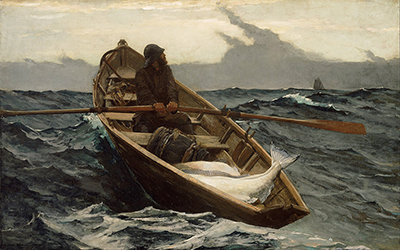Winslow Homer had constantly been deeply inspired by the oceanic. After spending more than a year and a half painting numerous paintings from the fishing community at Culler coats in the North Sea in 1882, he returned to the United States and established a studio in Maine, where the Homer family was during summer.
Painting and living at this place where the land meets the sea, Winslow represented some of the great nature and man themes. As he did in England, he continued to represent fishermen in his daily work, painting numerous small outlines and completing the big canvases. Fog Warning is one of the most famous. In the summer of 1884, he travelled to Cape Ann in Massachusetts, to draw and observe Gloucester's fishing fleet. While sailing coal aboard the schooners, Winslow later joined the drawing to obtain larger oil compositions. Possibly inspired by the fishermen he came across or the tales he heard when navigating with them, Winslow repeatedly painted and sketched the theme of isolation and work from different angles, reinforcing the lonely facets of the fisherman's fate.
The fog warning depicts one fisherman manoeuvring a dory with double or more huge halibut weights; the man put on his belt when the boat hits a wave and looks up at the sky toward a large sailboat, a "long, ominous cloud," as one critic called it. When the painting was first shown, it was referred to as a halibut fishing, but then Winslow seems to have gone to the trouble of correcting it. "The Winslow Homer’s picture," inscribed the Boston Evening Copy, "has to be resubmitted because the original sponsor did not provide this name. The real designation is 'The Fog Warning.' As the last title makes it precise, the canvas represents what was a common danger, namely: "the constant danger, in all seasons of the year, of fishermen, while they are in the boats, losing sight of the boats."
Even if the mother ship would honk the horn once, when the mist approached, dories general fleet was able to wrap itself in the mist quickly and easily before getting to safety. If you can get to the ship, is one of his most fruitful epics of the Marine. In The Fog Warning, he synthesized numerous themes that his artworks had in common since the mid-1880s. The Herring Net, which represents a large amount of herring. The fog warning evokes the harvest subjects through the great halibut at the foot of the dory. The purpose of the fog warning is uncertain: the sea is equally a provider and an opponent. Isolated contrary to the fog bank, the fisherman is caught in an ancient battle.




